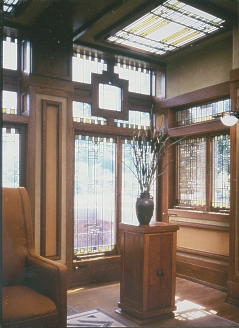
| Mathematics and Music in the Art Glass Windows of Frank Lloyd Wright |
|---|
P.O. Box 300
Otter Rock, Oregon 97369 USA
 It's
not poetic or particularly pleasing to hear but we humans are
basically pattern recognition devices. Our eyes take in the world
but what we really see are intricate patterns of lines and curves
and colors and brightness. Our ears hear sound, but we only recognize
music and language when we decode the signals into discreet patterns
of tone and rhythm. We crave finding patterns in the world around
us because it is the only way that we can give meaning to anything,
including ourselves. Nature may loathe a vacuum but humans cannot
stand a lack of patterns.
It's
not poetic or particularly pleasing to hear but we humans are
basically pattern recognition devices. Our eyes take in the world
but what we really see are intricate patterns of lines and curves
and colors and brightness. Our ears hear sound, but we only recognize
music and language when we decode the signals into discreet patterns
of tone and rhythm. We crave finding patterns in the world around
us because it is the only way that we can give meaning to anything,
including ourselves. Nature may loathe a vacuum but humans cannot
stand a lack of patterns.
As in most other matters, Frank Lloyd Wright was articulate about the role of leaded glass in his buildings. In 1908 he wrote:
The windows usually are provided with characteristic straight line patterns, absolutely flat and usually severe. The nature of the glass is taken into account in these designs as is also the metal bar used in their construction, and most of them are treated as metal "grilles" with glass inserted forming a simple rhythmic arrangement of straight lines and squares made as cunning as possible so long as the result is quiet.
As his autobiography reveals, from his earliest days as a boy on the farm in Wisconsin he was sensitive to the patterns of nature. Many years later he recalled,
I used to love to sit down at the drawing board with a T-square and triangle and concoct these patterns that you will see in the windows. I evolved a whole language of my own in connection with these things.
What was this language? We believe that in some houses it was a mathematical language which was essentially musical. It was musical in the sense that it was related to the mathematics which one finds in an ordinary piano octave. It was one feature of the design system which he used to control the entire building.
In this paper we study closely five windows from the Meyer May house (Grand Rapids, 1908). One of the attractions of the May house is that practically all of the glass has survived intact. In 1941 Henry-Russell Hitchcock observed that the windows of Wright's Coonley Playhouse of 1912 foreshadowed certain varieties of non-objective painting in Europe. Perhaps it is not too much to say that these windows at the May house anticipated the process which Piet Mondrian went through in the design of the paintings in his mature style of the nineteen-twenties. Concerning these works Robert Hughes remarks, "He did not calculate mathematical proportions. He had no special belief in the golden section or anything like it. His way of painting was wholly intuitive, a matter of inspired guesswork and adjustment." We believe that much the same comment could be made about Wright's design process for many of these windows. Interestingly, Hughes argues that the high point of Mondrian's intuitiveness came with his "Boogie Woogie" paintings. These were a response to modernist African American music. With Wright the situation is paradoxical. In his architecture he wanted to emulate Beethoven. In these windows he is much closer to Bartok. And he was constrained by came width and by the fact that windows and doors had to fill openings dictated by architectural requirements. And there was his determination to employ a strictly limited palette and to create a "light screen." Mondrian could select the size of his canvas and had a full palette of colors at his disposal. But the design process must have been strikingly similar. If, as Goethe remarked, "Architecture is frozen music," Wright came as close as any architect in recorded history to the idea in these windows.
ILLUSTRATION: The art glass windows designed by Frank Lloyd Wright in the Meyer May House, Grand Rapids, Michigan (USA), 1908.
ABOUT
THE AUTHOR
Leonard K. Eaton is Emil Lorch Professor of
Architecture Emeritus, the University of Michigan, where he taught
architectural history from 1950 to 1988. He has also taught at
Wayne State University, Michigan State University, and the University
of Victoria (British Columbia). In 1985 he was Margan Professor
at the University of Louisville. He took his B.A. with highest
honors at Williams College in 1943, and after war service with
the 10th Mountain Division, received an M.A. and Ph.D. from Harvard
University. His publications include: Landscape Artist in
America: the Life and Work of Jens Jensen (1964), Two
Chicago Architects and their Clients (1969), American
Architecture Comes of Age (1972) and Gateway Cities and
Other Essays (1989). He is best known for his work on Frank
Lloyd Wright, and is currently studying the anticipation of fractal
geometry in the late buildings by that architect. At Nexus '98
he presented "Fractal
Geometry in the LateWork of Frank Lloyd Wright: the Palmer House",
now available in Nexus
II: Architecture and Mathematics (1998).
|
Leonard K. Eaton, "Mathematics and Music in the Art Glass Windows of Frank Lloyd Wright", pp. 57-71 in Nexus III: Architecture and Mathematics, ed. Kim Williams, Pisa: Pacini Editore, 2000. http://www.nexusjournal.com/conferences/N2000-Eaton.html |
|
|
|
|
